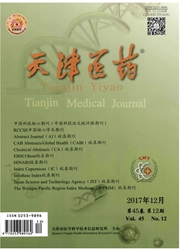

 中文摘要:
中文摘要:
目的:探讨叶酸和复合维生素B(VitB)对血浆同型半胱氨酸(Hey)及脑卒中的作用。方法:134例脑卒中患者依随机数字表法分为叶酸和复合VitB治疗的干预组和常规治疗的对照组各67例,分别检测各组患者入院和出院时血浆Hcy、D-二聚体(D—D)、纤维蛋白原(FIB)、三酰甘油(TG)、总胆固醇(TC)、高密度脂蛋白胆固醇(HDL—c)和低密度脂蛋白胆固醇(LDL—c)水平,观察干预效果。随访12个月,运用脑卒中残损评定法(SIAS)进行评价,确定患者预后情况。结果:干预后干预组血浆Hcy水平为(13.59±3.84)μmol/L,对照组为(14.78±4.32)μmol/L,均较干预前有所下降,差异有统计学意义(均P〈0.01)。干预组D—D、TC、TG、LDL—C和FIB水平治疗后均下降,治疗效果优于对照组,差异有统计学意义(P〈0.05或P〈0.01)。干预组脑卒中患者复发率(22.4%)低于对照组(44.1%)。前者SIAS评分为(20.72±2.33)分,明显高于后者的(12.70±1.77)分,差异有统计学意义(P〈0.01)。结论:补充叶酸和复合VitB可降低血浆Hcy水平,对预防和治疗脑卒中具有重要意义。
 英文摘要:
英文摘要:
Objective: To study the effect of folic acid and compound vitamin B (VitB) on plasma homocysteine (Hey) level and in patients with stroke. Methods: One hundred and thirty-four patients with stroke were randomly assigned to folic acid and compound Vit B intervention group (n=67) and routine therapy group (control, n=67). The plasma levels of Hcy, D-dimer (D-D), fibrinogen (FIB), triglyceride (TG), total cholesterol (TC), high density lipoprotein cholesterol (HDL-C)and low-density lipoprotein cholesterol (LDL-C) were measured to observe intervention effects at admission and discharge. After 12-month follow-up, all patients were evaluated by the stroke impairment assessment method (SIAS) to determine the prognosis. Results: After adding the folic acid and compound Vit B, the level of plasma Hcy was significantly lower in both groups [(13.59±3.84) μmol/L and (14.78±4.32) μmol/L] than that before the treatment (P 〈 0.05). Levels of D-D, TC, TG, LDL-C and FIB reduced significantly in intervention group, and the therapeutic effect was significantly better in the intervention group than that in control group (P 〈 0.05 or P 〈 0.01). The rate of stroke recurrence was significantly lower in intervention group (22.4%) than that of control group (44.1%, P = 0.021). The SIAS score was significantly higher in intervention group (20.72±2.33) than that of control group (12.70±1.77, P 〈 0.01). Conclusion: Folic acid and compound Vit B can reduce the plasma Hcy level, which plays a key role to prevent and treat for stroke.
 同期刊论文项目
同期刊论文项目
 同项目期刊论文
同项目期刊论文
 期刊信息
期刊信息
